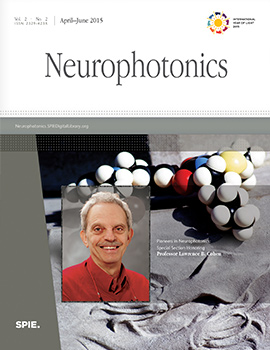Edmi Edison Rizki, Minako Uga, Ippeita Dan, Haruka Dan, Daisuke Tsuzuki, Hidenori Yokota, Keiji Oguro, Eiju Watanabe
Neurophotonics, Vol. 2, Issue 02, 025003, (May 2015) https://doi.org/10.1117/1.NPh.2.2.025003

TOPICS: Electroencephalography, Epilepsy, Hemodynamics, Video, Neurophotonics, Functional magnetic resonance imaging, Brain, Electrodes, Signal detection, Single photon emission computed tomography
Noninvasive localization of an epileptogenic zone is a fundamental step for presurgical evaluation of epileptic patients. Here, we applied long-term simultaneous functional near-infrared spectroscopy (fNIRS)/electroencephalogram (EEG) monitoring for focus diagnosis in patients with mesial temporal lobe epilepsy (MTLE). Six MTLE patients underwent long-term (8–16 h per day for 4 days) fNIRS/EEG monitoring for the occurrence of spontaneous seizures. Four spontaneous seizures were successfully recorded out of the six patients. To determine oxy-Hb amplitude, the period-average values of oxy-Hb across 20 s from the EEG- or clinically defined epileptic onset were calculated for both hemispheres from the simultaneously recorded fNIRS data. The average oxy-Hb values for the temporal lobe at the earlier EEG- or clinically defined epileptic onsets were greater for the epileptic side than for the contralateral side after EEG activity suppression, spike train, and clinical seizure in all four cases. The true laterality was determined based on the relief of seizures by selective amygdalo-hippocampectomy. Thus, oxy-Hb amplitude could be a reliable measure for determining the epileptic focus side. Long-term simultaneous fNIRS/EEG measurement serves as an effective tool for recording spontaneous seizures. Cerebral hemodynamic measurement by fNIRS would serve as a valuable supplementary noninvasive measurement method for presurgical evaluation of MTLE.



 Receive Email Alerts
Receive Email Alerts